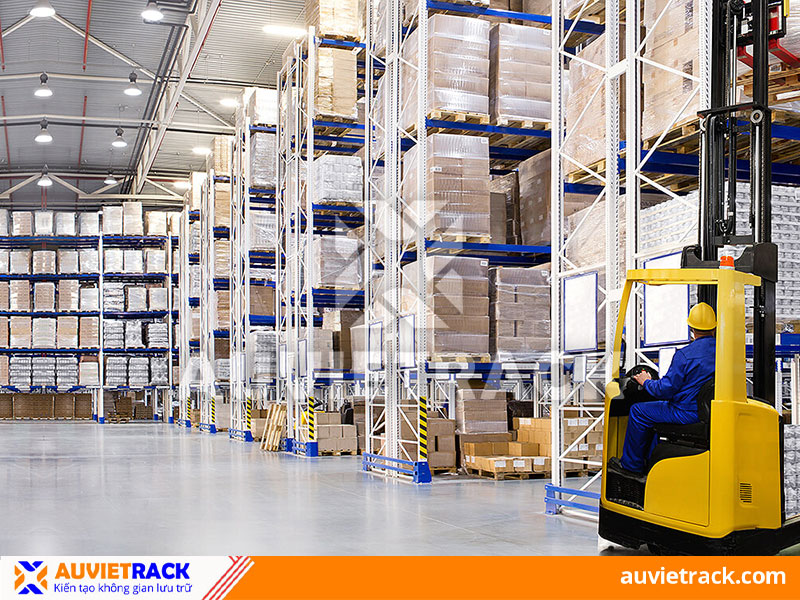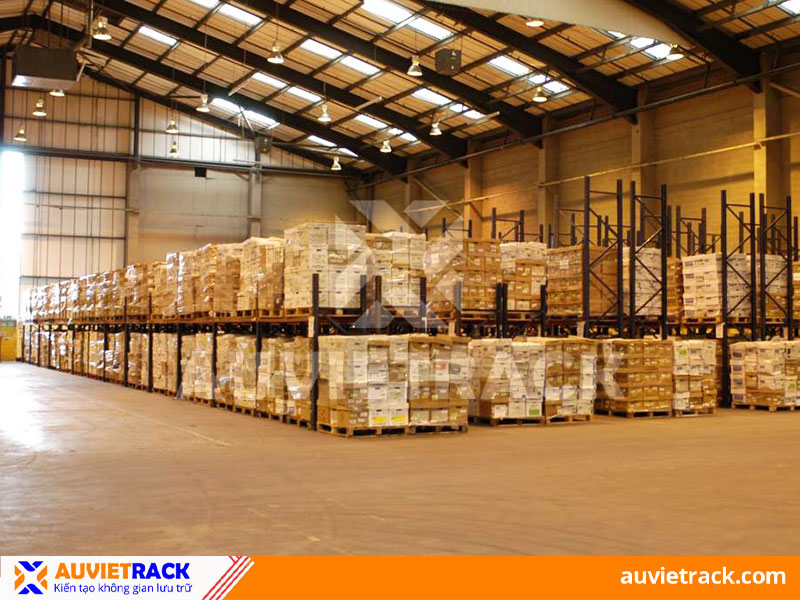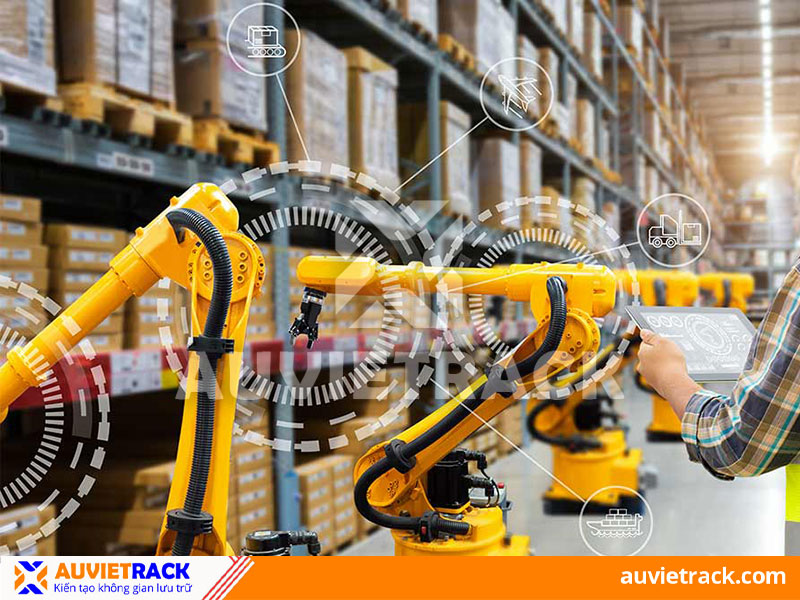What Is Warehousing in Logistics - Types of Logistics Warehousing
Every business that needs to store goods and logistics units must have heard a lot about warehouses. Warehousing is a very important part of the supply chain, not only used to store goods but also brings many other benefits. So what is warehousing and how many types are there? Let's learn everything about warehousing in logistics with Au Viet Rack!

What is a warehouse in logistics?
Warehousing includes both warehouse and yard. In which:
- Warehouse is understood as a closed goods storage system, with a roof and surrounding walls to separate it from the outside environment. Warehouses are often used to preserve inventory with high requirements for storage conditions.
- Yards are large spaces with flat terrain, which can be understood as yards, used to gather goods, store tools, instruments, means of transport,... with no storage environmental conditions required.
Thus, a warehouse is a space that can gather, store, and preserve inventory, tools, supplies, equipment, machinery, vehicles, etc. of a business. In addition, warehouses are also where businesses can control the status and location of goods to plan reasonable production and consumption.
 Warehouse is the storage place of a business
Warehouse is the storage place of a business
The role of warehouses in logistics
- Warehousing plays a very important role in the supply chain - logistics of businesses. All inventory such as supplies, raw materials, semi-finished products and finished products are stored and await the next processing step. Thanks to the use of warehouses, businesses can well preserve inventory against the risk of damage and loss.
- Warehouses help businesses arrange and classify goods more scientifically, making them easier to find and take. From there, goods are strictly controlled in terms of condition, quality, and quantity to reduce losses and plan production appropriately.
- Businesses will have enough time to plan distribution and consumption, and plan to transport goods to distributors, agents and retailers when finished products are stored in warehouses.
- Supplies and raw materials are always available for production thanks to being stored and preserved in warehouses. From there we can see that warehousing in logistics also helps businesses cope with the scarcity of input materials, ensuring the production process is not interrupted.
- Logistics warehouses, if built with a strict management plan, will help load and unload goods activities run smoothly, significantly minimizing errors when operating the supply chain.
Function of warehouse in logistics
- Gathering goods: a logistics yard is a place to gather goods transferred from outside or gather goods waiting to be transported to another place. Depending on the requirements of each type of goods, people can add a roof to protect them from rain and sun to avoid being damaged while waiting for the next processing step.
- Classification of goods: goods entering the logistics warehouse will be divided clearly and reasonably according to the wishes of the business. From there, warehousing helps reduce confusion and makes it easier to retrieve goods.
- Preserving goods according to standards: each type of goods has different requirements for preservation conditions, so they need to be stored in warehouses with appropriate conditions. Therefore, warehouses are very diverse in types to meet the best preservation requirements.
- Consolidation and separation of goods: warehouse is where goods are gathered, classified and separated into small batches to serve different needs.
- Packaging: some warehouses in logistics have professional packaging areas to package goods before being distributed and consumed.
- Control of goods: businesses can not only plan strict warehouse management or can apply new technology and automation in the management stage to improve the efficiency of inventory use.
 Warehousing helps control goods better
Warehousing helps control goods better
The most popular types of warehouses in logistics today
CFS Warehouse (Container Freight Station)
Container Freight Station warehouse, briefly known as CFS warehouse, is a quite familiar type of logistics warehouse for retail shipping businesses. At the CFS warehouse, goods will be collected, classified for shipping locations and arranged into containers. The most characteristic thing about CFS warehouses is that retail goods that cannot fill the container will be combined with other retail shipments, so it will be very convenient for transportation, faster and more cost-effective.
Bonded Warehouse
Bonded warehouses are a very typical and popular type of warehouse in today's supply chain. The goods owner will bring his goods to the bonded warehouse and authorize or transfer ownership to the warehouse owner. The bonded warehouse owner will carry out customs procedures such as reinforcing, dividing, packaging, combining goods, maintaining goods, classifying goods or performing other services for goods from domestic and foreign countries brought to the warehouse.
 Bonded warehouses in the supply chain
Bonded warehouses in the supply chain
Private Warehouse
Private warehouses are warehouses owned only by a certain business. Usually, these businesses are large-scale corporations, companies and companies specializing in goods storage services because the initial investment capital is very high. However, using exclusive warehouses will allow businesses to be more proactive in using warehouses, avoid confusion, loss, and store more quickly because these warehouses are often built close to their manufacturing plants. ,
Public Warehouse
Public storage is a form of renting shared storage for a short period of time. This type of warehouse does not require businesses to rent for a long time and the rental price is also very affordable. Businesses often rent public warehouses to temporarily store goods before finding additional warehouses.
Automated Warehouse
Automated warehouses are warehouses that apply advanced technology in the warehouse management process. Using automatic warehouses is much more professional and convenient than traditional warehouses because they are managed with smart software. Warehouse management software will help businesses control the status of stored goods, manage orders and plan the movement and distribution of goods. In addition, the automatic warehouse also has modern equipment to serve the movement of goods. Thanks to automatic machinery, everything in the warehouse runs smoothly, quickly and with few errors.
 Automated warehouses apply advanced technology
Automated warehouses apply advanced technology
Chill Warehouse
For businesses that own perishable goods, cool storage is a great choice. The temperature in cool storage usually ranges from - 10 degrees Celsius to 12 degrees Celsius depending on the storage conditions of the goods. The cool warehouse is built with good insulation materials, the racks in the cold storage are also designed to be well ventilated so that the goods have maximum exposure to cold air.
Cold Storage
Freezer storage has temperatures from -22 degrees Celsius to -18 degrees Celsius used to preserve perishable goods when stored at normal temperatures such as seafood, livestock products, and processed foods. ,... Like cool warehouses, cold warehouses are built with insulating materials and the storage area must ensure high ventilation. However, cold warehouses will need to take maximum advantage of the storage space, as it can store a large amount of goods in a smaller warehouse space because the cost of operating cold storage is very high.
 Frozen warehouse used for long-term storage
Frozen warehouse used for long-term storage
Tax suspension warehouse
The concept of a tax-suspension warehouse is clearly stated that raw materials and supplies that have been imported that have cleared customs but have not yet paid taxes will be stored there.
Climate-controlled warehouse
Climate-controlled warehouses are equipped with systems that dynamically adjust temperature and humidity relative to climatic conditions outside the warehouse. Thanks to that, the goods in the warehouse are always kept in the best condition before being consumed. Most types of goods that need to be stored in climate-controlled warehouses require strict storage conditions and are susceptible to damage.
Above are the most common types of warehouses in the supply chain today. Hopefully this article helps you better understand warehousing in logistics. Each type of warehouse will meet the different storage needs of businesses. Businesses need to carefully consider their needs to choose to use the appropriate type of logistics warehousing service to save time and warehousing costs in logistics.
